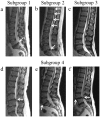FokI polymorphism in the vitamin D receptor gene (VDR) and its association with lumbar spine pathologies in the Italian population: a case-control study
- PMID: 24810167
- PMCID: PMC4014587
- DOI: 10.1371/journal.pone.0097027
FokI polymorphism in the vitamin D receptor gene (VDR) and its association with lumbar spine pathologies in the Italian population: a case-control study
Abstract
Alterations in vitamin D homeostasis, mainly involving its nuclear receptor (VDR), could have a role in the pathophysiology of the spine. The association between VDR polymorphisms and spine disorders has been analyzed in different ethnic groups, focusing on the functional FokI polymorphism. However, so far, inconsistent findings were reported. The aims of this study were to evaluate, in the Italian white population, the VDR FokI polymorphism frequencies distribution in subjects with clearly defined lumbar spinal pathologies compared to asymptomatic controls and to analyze the interplay of genetic and conventional risk factors. Using a case-control design, 267 patients with spinal disorders and 220 asymptomatic controls were enrolled, evaluating their exposition to putative risk factors. Patients' clinical assessment was performed by Magnetic Resonance Imaging. FokI polymorphism (rs2228570) was detected by PCR-RFLP. Genotypes were designated by a lowercase letter (f allele, T nucleotide) for the presence of the restriction site and by a capital letter (F allele, C nucleotide) for its absence. Family history, higher age and BMI, exposure to vibration, physical job demand, smoking habit and lower practice of leisure physical activity were associated with spinal disorders. The FF genotype and F allele represented approximately 2-fold risk factors to develop discopathies and/or osteochondrosis concomitant with disc herniation, while f allele was protective. In conclusion, the link we observed between VDR FokI variants and specific lumbar spine pathologies suggests that spinal tissue degeneration is influenced by the genetic background. Future studies should evaluate the signaling pathways involving alterations in VDR and influencing the development and/or progression of spine disorders.
Conflict of interest statement
Figures


Similar articles
-
Gender differences in the VDR-FokI polymorphism and conventional non-genetic risk factors in association with lumbar spine pathologies in an Italian case-control study.Int J Mol Sci. 2015 Feb 9;16(2):3722-39. doi: 10.3390/ijms16023722. Int J Mol Sci. 2015. PMID: 25671813 Free PMC article.
-
BsmI, ApaI and TaqI Polymorphisms in the Vitamin D Receptor Gene (VDR) and Association with Lumbar Spine Pathologies: An Italian Case-Control Study.PLoS One. 2016 May 5;11(5):e0155004. doi: 10.1371/journal.pone.0155004. eCollection 2016. PLoS One. 2016. PMID: 27149110 Free PMC article.
-
FokI polymorphism at translation initiation site of the vitamin D receptor gene predicts bone mineral density and vertebral fractures in postmenopausal Italian women.J Bone Miner Res. 1999 Aug;14(8):1379-86. doi: 10.1359/jbmr.1999.14.8.1379. J Bone Miner Res. 1999. PMID: 10457270 Clinical Trial.
-
Interplay between low plasma RANKL and VDR-FokI polymorphism in lumbar disc herniation independently from age, body mass, and environmental factors: a case-control study in the Italian population.Eur Spine J. 2016 Jan;25(1):192-199. doi: 10.1007/s00586-015-4176-7. Epub 2015 Aug 11. Eur Spine J. 2016. PMID: 26261013
-
Association Between FokI Polymorphism of Vitamin D Receptor Gene and Lumbar Spine Disc Degeneration: A Systematic Review and Meta-Analysis.Am J Phys Med Rehabil. 2021 May 1;100(5):492-500. doi: 10.1097/PHM.0000000000001588. Am J Phys Med Rehabil. 2021. PMID: 32932361
Cited by
-
Endplate Lesions of the Lumbar Spine: Biochemistry and Genetics.Genes (Basel). 2025 Jun 26;16(7):738. doi: 10.3390/genes16070738. Genes (Basel). 2025. PMID: 40725395 Free PMC article.
-
Vitamin D Receptor gene polymorphisms and plasma levels are associated with lumbar disc degeneration.Sci Rep. 2019 May 24;9(1):7829. doi: 10.1038/s41598-019-44373-2. Sci Rep. 2019. PMID: 31127184 Free PMC article.
-
Vitamin D's Effect on the Proliferation and Inflammation of Human Intervertebral Disc Cells in Relation to the Functional Vitamin D Receptor Gene FokI Polymorphism.Int J Mol Sci. 2018 Jul 9;19(7):2002. doi: 10.3390/ijms19072002. Int J Mol Sci. 2018. PMID: 29987250 Free PMC article.
-
Relationship Between Vitamin D Receptor Gene BsmI Polymorphism and Fibromyalgia Syndrome.Cureus. 2022 Jul 21;14(7):e27113. doi: 10.7759/cureus.27113. eCollection 2022 Jul. Cureus. 2022. PMID: 36000140 Free PMC article.
-
Association Between VDR FokI Polymorphism and Intervertebral Disk Degeneration.Genomics Proteomics Bioinformatics. 2015 Dec;13(6):371-6. doi: 10.1016/j.gpb.2015.11.003. Epub 2016 Jan 6. Genomics Proteomics Bioinformatics. 2015. PMID: 26772150 Free PMC article.
References
-
- Andersson GB (1999) Epidemiological features of chronic low-back pain. Lancet 354: 581–585. - PubMed
-
- Rubin DI (2007) Epidemiology and risk factors for spine pain. Neurol Clin 25: 353–371. - PubMed
-
- Luoma K, Riihimaki H, Luukkonen R, Raininko R, Viikari-Juntura E, et al. (2000) Low back pain in relation to lumbar disc degeneration. Spine (Phila Pa 1976) 25: 487–492. - PubMed
-
- Borenstein DG (2001) Epidemiology, etiology, diagnostic evaluation, and treatment of low back pain. Curr Opin Rheumatol 13: 128–134. - PubMed
-
- Frymoyer JW (1992) Lumbar disk disease: epidemiology. Instr Course Lect 41: 217–223. - PubMed
Publication types
MeSH terms
Substances
LinkOut - more resources
Full Text Sources
Other Literature Sources
Medical

